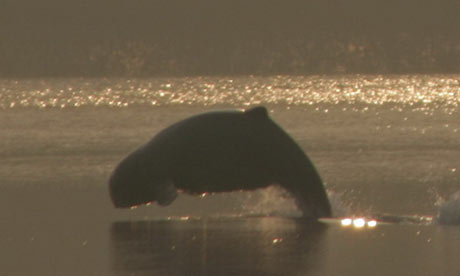Population of 6,000 endangered dolphins under threat from climate change and fishing, US conservationists warn
- guardian.co.uk, Wednesday 1 April 2009 12.51 BST
- Article history

New study shows that today 6,000 Irrawaddy dolphins are alive and swimming in Bangladesh. Photograph: WCS
Conservationists claim to have found thousands of rare Irrawaddy dolphins on the Bangladesh coast, but warn that the newly discovered population is under threat from climate change and fishing.
Researchers from the New York-based Wildlife Conservation Society (WCS) said they have found nearly 6,000 Irrawaddy dolphins living in the freshwater regions of Bangladesh's Sundarbans mangrove forest and nearby waters in the Bay of Bengal.
The largest known populations of Irrawaddy dolphins to date have numbered in the low hundreds or less – at least 125 in the Mekong river, 77 in the Malampaya Sound in the Philippines and up to 100 in the Mahakam River, Indonesia.
Until this new Bangladesh population was found, figures from the International Union for Conservation of Nature (IUCN) estimated the Sundarbans population to be around 450. WCS says it used rigorous scientific techniques in an area where little marine mammal research has taken place to document the new population.
"The number of animals could be higher – or lower," said Howard Rosenbaum, the director of WCS's ocean giants cetacean programme. "Our best estimate given the science is that there are 6,000. It sounds a lot but the Sundarbans cover a huge area. When you look at the areas that have been surveyed before the populations are low as they are in areas impacted by human development. But this area had never before been surveyed. We're really excited and this finding gives us great hope but this species is still very vulnerable."
The discovery of a new population is an important finding as scientists and conservation groups do not know how many Irrawaddy dolphins remain across south and south-east Asia. The species, related to orcas or killer whales, were listed in 2008 as "vulnerable" on the IUCN's "red list" of endangered species due to declines in known populations.
"This discovery gives us great hope that there is a future for Irrawaddy dolphins," said Brian D Smith, the study's lead author. "Bangladesh clearly serves as an important sanctuary for Irrawaddy dolphins, and conservation in this region should be a top priority."
"With all the news about freshwater environments and the state of the oceans, WCS's discovery that a thriving population of Irrawaddy dolphins exists in Bangladesh gives us hope for protecting this and other endangered species and their important habitats," said Steven E Sanderson, the president and chief executive of the WCS.
The results of the study were announced yesterday at the world's first international conference on marine mammal protected areas in Maui, Hawaii, and published in the Journal of Cetacean Research and Management.
But the scientists warned that the dolphins are becoming increasingly threatened by accidental entanglement in fishing nets. Declining freshwater supplies also pose a threat – from upstream water diversions such as dams and by rising sea levels caused by climate change that will see the loss of freshwater habitats.
These problems also threaten the Ganges river dolphins, an endangered species that also inhabits the Sundarbans. The recent likely extinction of the Yangtze river dolphin, or baiji, is a potent reminder of how vulnerable freshwater dolphins are to extinction via the impacts of humans, the organisation said.
The Irrawaddy dolphin grows to some 2-2.5 metres in length (6.5-8ft) and lives in large rivers, estuaries, and freshwater lagoons in south and south-east Asia.
As recently as 1996 they were listed as "data deficient" as not enough was known about the species and its range and habitats.
Since then, the IUCN said, five populations have been listed as critically endangered, and the range of the populations and their numbers have declined as they have been caught as bycatch and faced habitat degradation.
Scientists estimated the numbers of the new Bangladesh population using a technique called distance sampling – taking a boat along plotted grid lines and counting the numbers of animals seen, accounting for how many are above or below the surface and whether the same animal has been counted twice. The team covered 1,000 sq km of water during the survey in 2004.
Mark Simmonds, the international director of science for the UK-based Whale and Dolphin Conservation Society, said: "This discovery is an interesting one as it reflects the fact that now the Sundarbans have been more fully surveyed, we have a much better idea of how many animals are there. Irrawaddy dolphins are getting rarer and rarer in that part of the world. To find 6,000 isn't huge – but it's significant – and it does show that when you look for something and survey properly you can get some interesting findings.
"But the most important thing is that mangrove habitat is incredibly threatened, and while it's great to know that they are full of dolphins, we wish they could live somewhere else. Mangroves are threatened by changes in the water passing through them – from extreme weather, sea level rises, changes in salinity and changes to water systems upstream. The Sundarbans system is important and needs better protection."
The WCS has asked Bangladesh authorities to establish a sanctuary for the dolphins in the Sundarbans mangrove forest.
Ainun Nishat, the Bangladesh head of International Union for Conservation of Nature, said the finding was an indication that "ecology in the area is not dead yet".
"There is plenty of food, mainly fish, in the area for the dolphins to eat," said Nishat, who was not involved in the study. "What is now needed is to restrict fishing in the area to protect the dolphins."

No comments:
Post a Comment